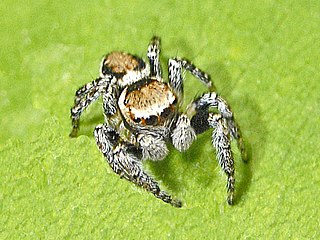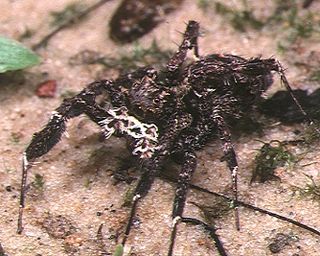
Jumping spiders are a group of spiders that constitute the family Salticidae. As of 2019, this family contained over 600 described genera and over 6,000 described species, making it the largest family of spiders at 13% of all species. Jumping spiders have some of the best vision among arthropods and use it in courtship, hunting, and navigation. Although they normally move unobtrusively and fairly slowly, most species are capable of very agile jumps, notably when hunting, but sometimes in response to sudden threats or crossing long gaps. Both their book lungs and tracheal system are well-developed, and they use both systems. Jumping spiders are generally recognized by their eye pattern. All jumping spiders have four pairs of eyes, with the anterior median pair being particularly large.

Portia labiata is a jumping spider found in Sri Lanka, India, southern China, Burma (Myanmar), Malaysia, Singapore, Java, Sumatra and the Philippines. In this medium-sized jumping spider, the front part is orange-brown and the back part is brownish. The conspicuous main eyes provide vision more acute than a cat's during the day and 10 times more acute than a dragonfly's, and this is essential in P. labiata′s navigation, hunting and mating.
Magyarus is a monotypic genus of Vietnamese jumping spiders containing the single species, Magyarus typicus. It was first described by Marek Michał Żabka in 1985, and is only found in Vietnam.

Evarcha falcata is a species of 'jumping spiders' belonging to the family Salticidae.

Saitis barbipes is a common jumping spider found in the Mediterranean region.
Thrandina is a genus of jumping spiders, with three species found in Ecuador. It is unique among New World salticids in having strikingly large posterior median eyes.

Maevia inclemens or the Dimorphic Jumping Spider is a relatively common and colorful jumping spider of North America. In the males there are two forms, a very rare phenomenon in zoology. These use different courting displays, and differ in appearance: the "tufted" morph has a black body and pedipalps ("palps"), three black tufts across its "head", and pale legs; and the "gray" morph has black and white stripes all over its body and legs, orange palps, and no tufts. However, each form accounts for 50% of the adult males, and they are equally successful in mating. A female of Maevia inclemens is 6.5 to 8.0 millimetres long, while males are 4.75 to 6.50 millimetres long.

Zygoballus sexpunctatus is a species of jumping spider which occurs in the southeastern United States where it can be found in a variety of grassy habitats. Adult spiders measure between 3 and 4.5 mm in length. The cephalothorax and abdomen are bronze to black in color, with reddish brown or yellowish legs. The male has distinctive enlarged chelicerae and front femora. Like many jumping spiders, Z. sexpunctatus males exhibit ritualized courtship and agonistic behavior.

Plexippus paykulli is a species of jumping spider. It is native to south east Asia but has spread to other parts of the world and globe. In the United States it is called the pantropical jumping spider. It is usually associated with buildings and may be found near light sources catching insects attracted by the light. It is named in honor of Gustaf von Paykull.

Carrhotus xanthogramma is a species of 'jumping spiders' belonging to the family Salticidae.

Portia fimbriata, sometimes called the fringed jumping spider, is a jumping spider found in Australia and Southeast Asia. Adult females have bodies 6.8 to 10.5 millimetres long, while those of adult males are 5.2 to 6.5 millimetres long. Both sexes have a generally dark brown carapace, reddish brown chelicerae ("fangs"), a brown underside, dark brown palps with white hairs, and dark brown abdomens with white spots on the upper side. Both sexes have fine, faint markings and soft fringes of hair, and the legs are spindly and fringed. However, specimens from New Guinea and Indonesia have orange-brown carapaces and yellowish abdomens. In all species of the genus Portia, the abdomen distends when the spider is well fed or producing eggs.

Portia schultzi is a species of jumping spider which ranges from South Africa in the south to Kenya in the north, and also is found in West Africa and Madagascar. In this species, which is slightly smaller than some other species of the genus Portia, the bodies of females are 5 to 7 mm long, while those of males are 4 to 6 mm long. The carapaces of both sexes are orange-brown with dark brown mottling, and covered with dark brown and whitish hairs lying over the surface. Males have white tufts on their thoraces and a broad white band above the bases of the legs, and these features are less conspicuous in females. Both sexes have tufts of orange to dark orange above the eyes, which are fringed with pale orange hairs. Males' abdomens are yellow-orange to orange-brown with blackish mottling, and on the upper sides are black and light orange hairs, and nine white tufts. Those of females are pale yellow and have black markings with scattered white and orange-brown hairs on the upper side. P. schultzi has relatively longer legs than other Portia, and a "lolloping" gait.
Portia africana is a jumping spider found in Angola, Cameroon, the Central African Republic, Gabon, Ghana, the Ivory Coast, Sierra Leone, Zaire and Zambia. Its conspicuous main eyes provide vision more acute than a cat's during the day and 10 times more acute than a dragonfly's, and this is essential in P. africana′s navigation, hunting and mating.
Rhene facilis is a species of jumping spider in the genus Rhene. The spider, spotted in South Africa and Tanzania, is small with distinctive female and male forms. The female is light brown, with grey and red hints, and has a distinctive epigyne. The male is darker in colour, with an almost black carapace and a dark brown abdomen with a white patterns, and has a slightly curved embolus. The male was first described in 2000 and the female in 2013.
Phlegra parvula is a jumping spider species in the genus Phlegra that lives in Tanzania. The female was first described in 2000.
Phlegra simplex is a jumping spider species in the genus Phlegra that lives in Tanzania and Zimbabwe. The male was first described in 2000.
Phlegra varia is a jumping spider species in the genus Phlegra that lives in Tanzania. The female was first described in 2000. It is closely related to Phlegra bresnieri and Phlegra chrysops.
Phlegra pusilla is a species of jumping spider in the genus Phlegra. The male was first described in 1994 from a sample from Yemen. The female was subsequently described in 2006, and the distribution of the species identified from across Africa from Senegal to Zimbabwe and into the Arabian Peninsula. The species is identified by a characteristic pattern on the carapace and the structure of the copulatory organs.

Pellenes geniculatus is a jumping spider species in the genus Pellenes. First named Attus geniculatus by Eugène Simon in 1868, it was given its current name by Simon in 1876. A small spider, between 3.35 and 5 mm long, it has a large range that stretches across Southern Europe, Africa and Central Asia. There is some variation between those found in Africa and in Europe and Asia, the former generally being slightly smaller. The head has a distinctive pattern of lines formed of white scales.

Carrhotus viduus is a species of spider in the family Salticidae. It is found in South and Southeast Asia. It is the type species of the genus Carrhotus.












